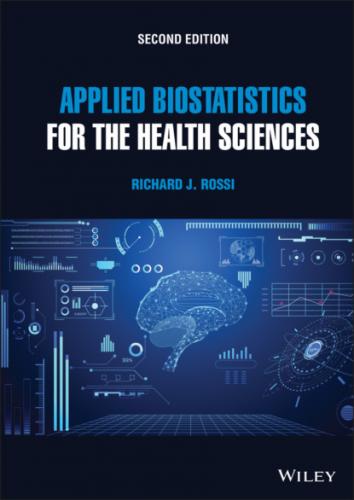Applied Biostatistics for the Health Sciences. Richard J. Rossi
628
644 629
645 630
646 631
647 632
648 633
649 634
650 635
651 636
652 637
653 638
654 639
655 640
656 641
657 642
658 643
659 644
660 645
661 646
662 647
663 648
664 649
665 650
666 651
667 652
668 653
669 654
670 655
671 656
672 657
673 658
674 659
675 660
676 661
677 662
678 663
679 664
680 665
681 666
682 667
PREFACE
Applied Biostatistics for the Health Sciences is intended for use in an introductory biostatistics class for undergraduates in the health sciences including students studying premedicine, nursing, pharmacy, bioinformatics, healthcare informatics, biochemistry, and applied health sciences. This textbook is also appropriate for a first course in statistics for medical students or graduate students in public health. In fact, this book was written for introducing students to biostatistics as well as for preparing students for the material covered in upper division applied statistics courses. The only prerequisite for a course taught from this textbook is a typical course in high school algebra II or college algebra.
Topic Coverage
The topics chosen for this book were chosen for pedagogical reasons and have been tried, tested, and adjusted over the past 40 years of teaching introductory courses in statistics. Throughout Applied Biostatistics for the Health Sciences, the primary emphasis is placed on the correct usage, interpretation, and the conceptual ideas associated with each biostatistical method that is discussed.
The textbook is organized in two parts with Chapters 1–7 covering the basic inferential biostatistical methods used to describe sample data arising in a biomedical or health-related study. Chapters 8–13 cover several modeling approaches that are commonly used with biomedical and healthcare data. In particular, the following topics are presented in this textbook.
Chapter 1: Introduction to Biostatistics. Chapter 1 provides an introduction to the ideas and basic terminology of biostatistics as well as the commonly used research protocols. Experiments are contrasted with observational studies and clinical trials are also discussed in Chapter 1. A description of the data sets used in several of the examples and exercises is given at the end of Chapter 1.
Chapter 2: Describing Populations. Chapter 2 introduces variables, populations, population parameters, probability, and the binomial and normal probability models. Several biomedical parameters are introduced in Chapter 2 including the prevalence of a disease, the specificity and sensitivity of a diagnostic test, and the relative risk associated with a disease and risk factor.
Chapter 3: Random Sampling. The basic ideas associated with random sampling are discussed in Chapter 3. In particular, the simple random sampling, stratified random sampling, random cluster sampling, and systematic random sampling plans are discussed including the determination of the appropriate sample size for estimating a mean or proportion with a prespecified bound on the error of estimation. The formulas for determining the overall sample size and its allocation for a stratified random sample may be considered as an optional topic and covered as time permits.
Chapter 4: Summarizing Random Samples. Several important graphical and numerical summary statistics for qualitative and quantitative variables are presented. In particular, along with the standard point estimators of the measures of location and dispersion, point estimators for estimating the prevalence of a disease, the sensitivity and specificity of a diagnostic test, the relative risk, and the coefficient of variation are presented in Chapter 4. The plug-in rule for estimating parameters is also included in this chapter.
Chapter 5: Measuring the Reliability of Statistics. The sampling distribution of an estimator is discussed in Chapter 5 with emphasis on evaluating the reliability of a point estimator. The topics discussed in Chapter 5 include properties of point estimators including the bias, standard error, bound on the error of estimation, and mean squared error associated with a point estimator. The Central Limit Theorem for the sample proportion and sample mean, the t distribution, and bootstrapping the sampling distribution of a point estimator are discussed in this chapter. The section on bootstrapping can be considered optional material to be covered if time permits.
Chapter 6: Confidence Intervals. Confidence intervals for a single proportion, a single mean, the difference of two proportions, the difference of two means, and the relative risk are presented in Chapter 6. Formulas for determining the sample size required for a prespecified margin of error are included for estimating a proportion, mean, and the difference between two proportions. Bootstrap confidence intervals are also discussed in this chapter and can be considered optional material.
